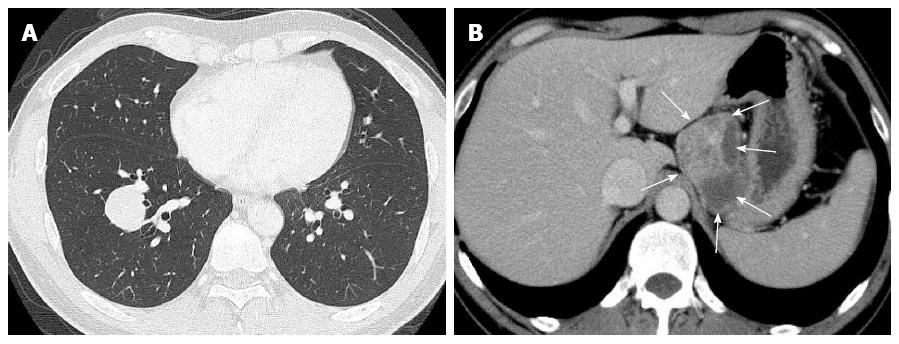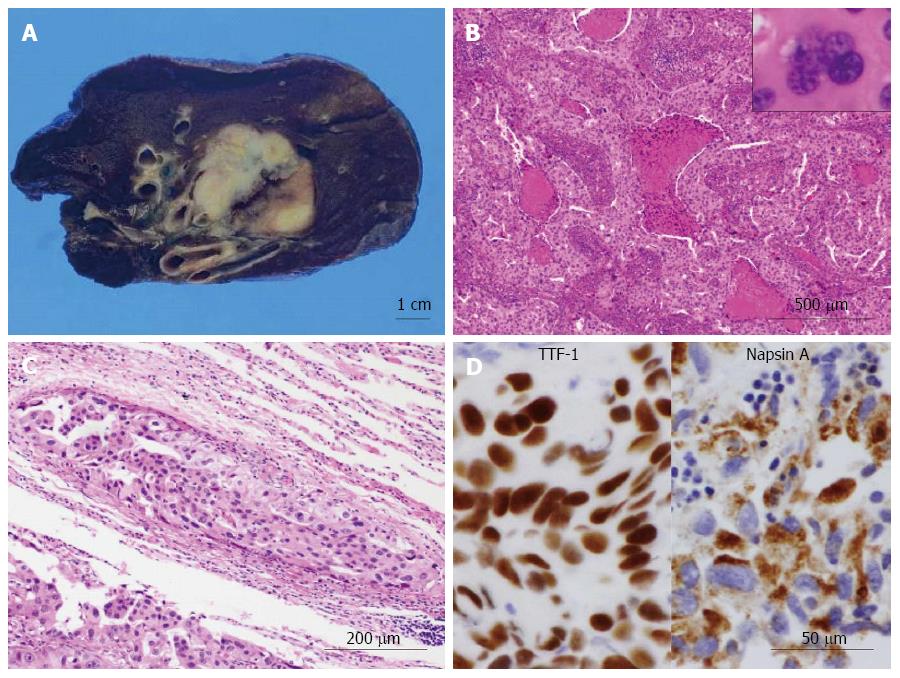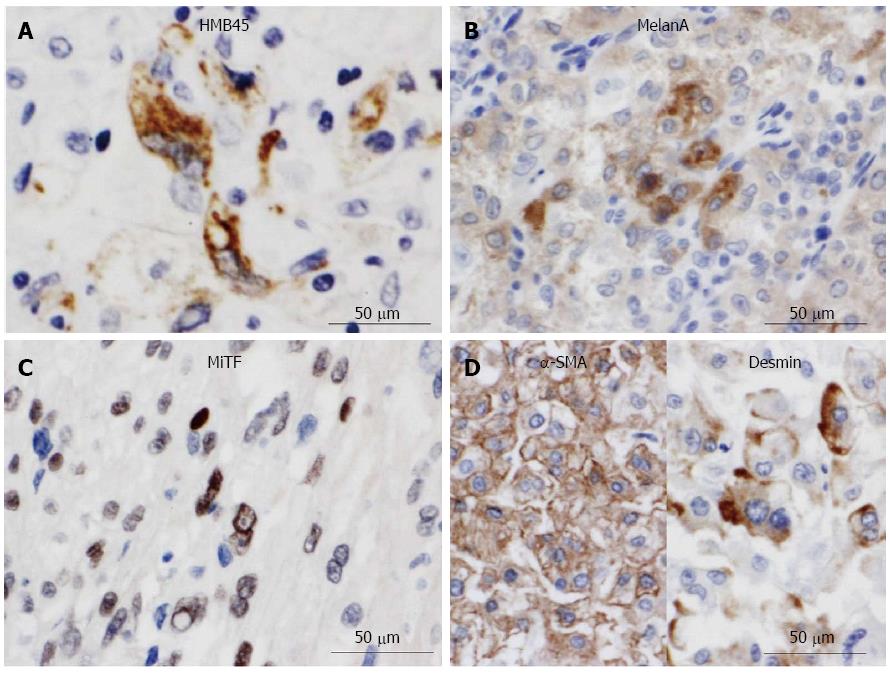Copyright
©The Author(s) 2015.
World J Gastroenterol. Jan 28, 2015; 21(4): 1349-1356
Published online Jan 28, 2015. doi: 10.3748/wjg.v21.i4.1349
Published online Jan 28, 2015. doi: 10.3748/wjg.v21.i4.1349
Figure 1 Findings of chest and abdominal computed tomography scan at surgery.
A: A chest computed tomography (CT) scan showed a relatively well-demarcated nodule, measuring approximately 30 mm × 30 mm, in the right lower lobe, S9; B: An abdominal CT scan showed a relatively well-defined huge mass with heterogeneously enhancement (arrows), measuring approximately 70 mm × 60 mm, attached to the gastric wall and separated from the left kidney and adrenal gland.
Figure 2 Gross, histological and immunohistochemical findings of poorly differentiated adenocarcinoma of the lung.
A: On gross examination, the cut surface showed a solid firm and lobulated mass, measuring 32 mm × 30 mm × 29 mm, which looked from gray-whitish to yellow-whitish in color, accompanied with focal necrosis and hemorrhage. The background had no remarkable change. Bar = 1 cm; B: Low to medium power view exhibited a proliferation of medium-sized to large atypical epithelial cells having hyperchromatic pleomorphic nuclei and abundant eosinophilic cytoplasm, predominantly arranged in an acinar or solid fashion with frequent necrotic foci (HE stains). Multi-nucleated giant tumor cells were readily encountered (inset). Bar = 500 μm; C: The tumor nests peripherally involved the vascular vessel (HE stains). Bar = 200 μm; D: In immunohistochemistry, these adenocarcinoma cells were specifically positive for thyroid transcription factor 1 (TTF-1) (left) and Napsin A (right), in nuclear and intracytoplasmic pattern, respectively. Bar = 50 μm.
Figure 3 Gross and microscopic examination of the resected specimen of malignant perivascular epithelioid cell tumor arising in the stomach.
A: Gross examination at surgery (left) and after fixation (right) showed that the huge tumor, measuring 73 mm × 65 mm × 61 mm, had gray-whitish to yellow-whitish cut surfaces with some hemorrhagic and yellowish necrotic foci, attached to the serosa of the lesser curvature on the gastric body (arrows) and separated from the left kidney and adrenal gland. Bars = 2 cm; B: Microscopically (low to medium power view), the abdominal tumor predominantly consisted of sheets or nests of markedly atypical epithelioid cells having hyperchromatic pleomorphic nuclei and abundant eosinophilic to clear cytoplasm, admixed with a large number of multi-nucleated giant cells (inset), supported by delicate fibrovascular septa (HE stains). Bar = 500 μm; C: On high-power view, these nests displayed an alveolar or trabecular growth pattern (right), characteristically displaying a radial perivascular fashion (left) (HE stains). The large tumor cells sometimes showed atypical mitosis with relatively high mitotic rates (more than 2 per 10 high-power fields) (inset). Bars = 200 μm or 100 μm; D: Moreover, vascular permeation of the infiltrative tumor nests was partly noted in the peripheral areas (HE stains). Bar = 200 μm.
Figure 4 Immunohistochemical examination of malignant perivascular epithelioid cell tumor of the stomach.
The highly atypical epithelioid cells were specifically positive for melanocytic markers, such as HMB45 (A), Melan A (B), and microphthalmia transcription factor (MiTF) (C), and muscle markers, such as α-smooth muscle actin (SMA) markers (D) or desmin (D). Bars = 50 μm.
- Citation: Yamada S, Nabeshima A, Noguchi H, Nawata A, Nishii H, Guo X, Wang KY, Hisaoka M, Nakayama T. Coincidence between malignant perivascular epithelioid cell tumor arising in the gastric serosa and lung adenocarcinoma. World J Gastroenterol 2015; 21(4): 1349-1356
- URL: https://www.wjgnet.com/1007-9327/full/v21/i4/1349.htm
- DOI: https://dx.doi.org/10.3748/wjg.v21.i4.1349












